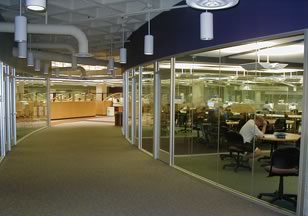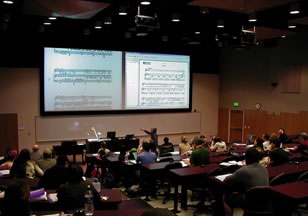Chapter 37. University of Arizona: Manuel Pacheco Integrated Learning Center
What Is It?
The University of Arizona in Tucson, Arizona, serves 28,000 undergraduate and 9,000 graduate students. It is a public land-grant Research I institution that boasts a heritage as Arizona's first university with leadership in a variety of research areas.
The Manuel Pacheco Integrated Learning Center (ILC) serves as a home to first-year students at the University of Arizona. The 118,000-square-foot facility houses 14 classrooms, a 300-computer information commons, and a variety of other spaces. The ILC is designed to provide first-year students with state-of-the-art instructional materials, academic advising and student support services, and access to information resources. When not providing these services to first-year students, the ILC is used by a broad spectrum of classes on campus.
The ILC provides students and faculty with the following services:
- Technology-rich classrooms
- Study, meeting, and social spaces
- Wireless networking
- Midlevel computing for course assignments and high-end computing for multimedia development
- A variety of information resources [http://www.library.arizona.edu/applications/quickHelp/] such as reference tools, tutorials, guides, and course-related materials and a variety of digital exhibits.
- In-depth one-on-one multimedia development support
- Technical and instructional support services
- Academic advising and exploration of majors for undecided students, and tutoring specifically focused on lower-division math/science courses
Classrooms: Each of the 14 classrooms is equipped with technology and projection systems with wired and wireless access for faculty and student laptops. For more information on the four lecture halls (one holding 300 students and three accommodating 150 students), four midsize classrooms (60 students), and six small classrooms (30 students).
OSCR Underground: The Office of Student Computing Resources' main help desk, known as OSCR Underground, provides on-site assistance for student-owned hardware and software.
Information commons: The information commons [http://www.library.arizona.edu/ic/] provides access to desktop computing and a variety of library resources. (See Figure 1.)
Figure 1. Information Commons

Multimedia Zone: The Multimedia Zone, another OSCR support location for students, provides high-end computing for multimedia projects.
University College: University College is one of the university's 15 degree-granting undergraduate colleges. It is housed in the ILC and provides academic advising, tutoring, and other support for new students, especially transitional, interdisciplinary, and/or exploratory students.
Courtyard: The courtyard serves as a meeting place and is often used by faculty for outdoor class activities. (See Figure 2.)
Figure 2. Courtyard

What Happens Here?
The lecture halls and classrooms support instructional activities for a variety of courses. The building primarily supports courses in the university's general education program. When not used by these courses, graduate and upper division courses also use the facility. (See Figure 3.)
Figure 3. Lecture Hall

The ILC provides access to a 300-student responder system, which can be divided into smaller groupings. In addition, networked laptop computers allow students to respond and interact during classes. A 150-student lecture hall equipped with video capture allows classes taught in this room to be digitized and logged to create a searchable transcript and streamed via the Web (http://www.svl.arizona.edu/).
The information commons provides access to a variety of different information tools from the university's library system (reference material, digital exhibits, tutorials, and so on). It also provides hardware and software to create digital materials to support class work. The information commons is open 24 hours a day, five days a week, with reduced hours on weekends. Group study rooms placed around the periphery of the commons are available for students to use for individual or group study. The commons purposely provides two chairs for every desktop computer to promote group work. These chairs move throughout the commons as students come together to work on projects. In addition, the courtyard is used for a variety of formal and informal gatherings; students congregate in a number of areas.
How Is Technology Used?
The ILC features wireless high-speed Internet access throughout. It also provides access to a 300-student radio frequency responder system that can be configured for use in the large lecture hall (300 students), the smaller lecture halls (150 students in two halls at a time), or three simultaneous uses in smaller numbers.
The Office of Student Computing Resources supports more than 100 laptop computers. Forty-five of these systems are permanently placed in one of the midsize classrooms; the rest are delivered to classrooms in laptop carts. In addition, each classroom has a teaching station that provides access to a desktop computer and connection for a laptop. The stations have a separate touch panel to control computer and video input, audio, and lighting. Each station has a visual presenter (electronic overhead), VCR, and DVD player. The desktop computer is equipped with a screen that doubles as an electronic whiteboard. OSCR also provides high-end multimedia workstations for students in the Multimedia Zone.
What Makes the Space Successful?
Four factors contribute the success of the ILC: a collaborative design process, shared oversight of the facility, technology and instructional support, and ongoing assessment.
Collaborative design: The initial design process solicited input from a broad spectrum of users. The design team consulted faculty and students along with experts in teaching and learning, technology-enhanced instruction, information sciences, networking, and facilities design to develop a set of guidelines for the facilities. These guidelines were then communicated to the architect who, in the words of many on the design team, "got it" in terms of the mission of the facility. These guidelines have been used to monitor the progress of the different types of activities that occur in the building.
Shared oversight: The ILC is not associated with an academic college or unit, as is common with other facilities on campus. A management team of representatives from instruction, computing, academic advising/tutoring, and the university library governs the activities in the building. This team communicates regularly with the vice provost for academic affairs, CIO, and dean of the libraries to ensure that the activities in the ILC mesh with other instructional activities.
Technology and instructional support: Members of the management team are responsible for equipment services and OSCR Underground. Personnel from each unit are housed in the ILC, providing immediate access to technical and instructional support.
Assessment: The management team conducts annual surveys to determine if current resources meet the users' instructional needs. This data allows the management team to adjust services and direct resources to maintain and update the infrastructure.
What Principles Were Behind the Design?
Four principles went into the design: agility, multifunctional use of the spaces, transparency, and seamless access. The systems in the ILC can be easily reconfigured based on data collected from student and faculty surveys, and the different spaces in the ILC support individual, group, and class work in quiet and semi-quiet environments. The technology resources are designed to allow faculty to experiment and implement a variety of different instructional strategies.
The design committee, working with the architect, decided that the ILC should provide a level of transparency to permit users of the information commons and courtyard to see what goes on in these spaces. In addition, access to the Internet, library, and other campus resources is designed to be as seamless as possible.
What Is Unique or Noteworthy?
The design committee collected input from a variety of campus constituents, architects, and space planners during the design process, and the management team continues to solicit this input through online surveys and a variety of other data collection techniques. The design team chose to locate the ILC completely underground, allowing the facility to be in the center of campus without violating the sacrosanct space of the mall and Old Main, the original campus building. The instructional facilities link to the university library through the information commons. (See links to the courtyard and the mall at <http://www.ilc.arizona.edu/>.)
The ILC provides first-year students with a single location for important support services as well as a rich instructional environment. This assists the campus in meeting a prime university goal of increasing student retention by providing the best resources possible to first-year students. The general education courses supported by the ILC are multidisciplinary in nature and provide students with a broad foundation of courses in English, math, foreign languages, natural sciences, individuals and societies, and traditions and cultures. Faculty in general education courses are encouraged to collaborate with instructors of other courses. The ILC provides locations where faculty can meet.
While all instructional spaces on campus are controlled through central scheduling, many academic units feel a sense of ownership of the rooms within their buildings. Since the ILC does not "belong" to any academic unit, it can serve as a university-wide resource. Management of the ILC by the management team provides a broad perspective in its use and maintenance.
About the Author
Chris Johnson is a consultant and an adjunct assistant professor at the University of Arizona South.